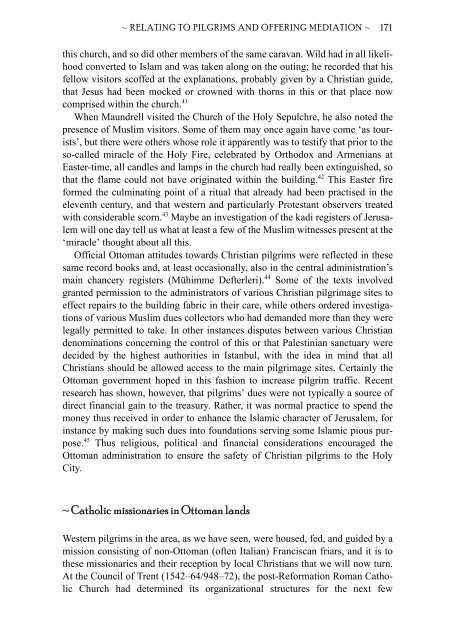The Ottoman Empire and the World Around It - Course Information
The Ottoman Empire and the World Around It - Course Information
The Ottoman Empire and the World Around It - Course Information
Create successful ePaper yourself
Turn your PDF publications into a flip-book with our unique Google optimized e-Paper software.
~ RELATING TO PILGRIMS AND OFFERING MEDIATION ~ 171<br />
this church, <strong>and</strong> so did o<strong>the</strong>r members of <strong>the</strong> same caravan. Wild had in all likelihood<br />
converted to Islam <strong>and</strong> was taken along on <strong>the</strong> outing; he recorded that his<br />
fellow visitors scoffed at <strong>the</strong> explanations, probably given by a Christian guide,<br />
that Jesus had been mocked or crowned with thorns in this or that place now<br />
comprised within <strong>the</strong> church. 41<br />
When Maundrell visited <strong>the</strong> Church of <strong>the</strong> Holy Sepulchre, he also noted <strong>the</strong><br />
presence of Muslim visitors. Some of <strong>the</strong>m may once again have come ‘as tourists’,<br />
but <strong>the</strong>re were o<strong>the</strong>rs whose role it apparently was to testify that prior to <strong>the</strong><br />
so-called miracle of <strong>the</strong> Holy Fire, celebrated by Orthodox <strong>and</strong> Armenians at<br />
Easter-time, all c<strong>and</strong>les <strong>and</strong> lamps in <strong>the</strong> church had really been extinguished, so<br />
that <strong>the</strong> flame could not have originated within <strong>the</strong> building. 42 This Easter fire<br />
formed <strong>the</strong> culminating point of a ritual that already had been practised in <strong>the</strong><br />
eleventh century, <strong>and</strong> that western <strong>and</strong> particularly Protestant observers treated<br />
with considerable scorn. 43 Maybe an investigation of <strong>the</strong> kadi registers of Jerusalem<br />
will one day tell us what at least a few of <strong>the</strong> Muslim witnesses present at <strong>the</strong><br />
‘miracle’ thought about all this.<br />
Official <strong>Ottoman</strong> attitudes towards Christian pilgrims were reflected in <strong>the</strong>se<br />
same record books <strong>and</strong>, at least occasionally, also in <strong>the</strong> central administration’s<br />
main chancery registers (Mühimme Defterleri). 44 Some of <strong>the</strong> texts involved<br />
granted permission to <strong>the</strong> administrators of various Christian pilgrimage sites to<br />
effect repairs to <strong>the</strong> building fabric in <strong>the</strong>ir care, while o<strong>the</strong>rs ordered investigations<br />
of various Muslim dues collectors who had dem<strong>and</strong>ed more than <strong>the</strong>y were<br />
legally permitted to take. In o<strong>the</strong>r instances disputes between various Christian<br />
denominations concerning <strong>the</strong> control of this or that Palestinian sanctuary were<br />
decided by <strong>the</strong> highest authorities in Istanbul, with <strong>the</strong> idea in mind that all<br />
Christians should be allowed access to <strong>the</strong> main pilgrimage sites. Certainly <strong>the</strong><br />
<strong>Ottoman</strong> government hoped in this fashion to increase pilgrim traffic. Recent<br />
research has shown, however, that pilgrims’ dues were not typically a source of<br />
direct financial gain to <strong>the</strong> treasury. Ra<strong>the</strong>r, it was normal practice to spend <strong>the</strong><br />
money thus received in order to enhance <strong>the</strong> Islamic character of Jerusalem, for<br />
instance by making such dues into foundations serving some Islamic pious purpose.<br />
45 Thus religious, political <strong>and</strong> financial considerations encouraged <strong>the</strong><br />
<strong>Ottoman</strong> administration to ensure <strong>the</strong> safety of Christian pilgrims to <strong>the</strong> Holy<br />
City.<br />
~ Catholic missionaries in <strong>Ottoman</strong> l<strong>and</strong>s<br />
Western pilgrims in <strong>the</strong> area, as we have seen, were housed, fed, <strong>and</strong> guided by a<br />
mission consisting of non-<strong>Ottoman</strong> (often <strong>It</strong>alian) Franciscan friars, <strong>and</strong> it is to<br />
<strong>the</strong>se missionaries <strong>and</strong> <strong>the</strong>ir reception by local Christians that we will now turn.<br />
At <strong>the</strong> Council of Trent (1542–64/948–72), <strong>the</strong> post-Reformation Roman Catholic<br />
Church had determined its organizational structures for <strong>the</strong> next few


